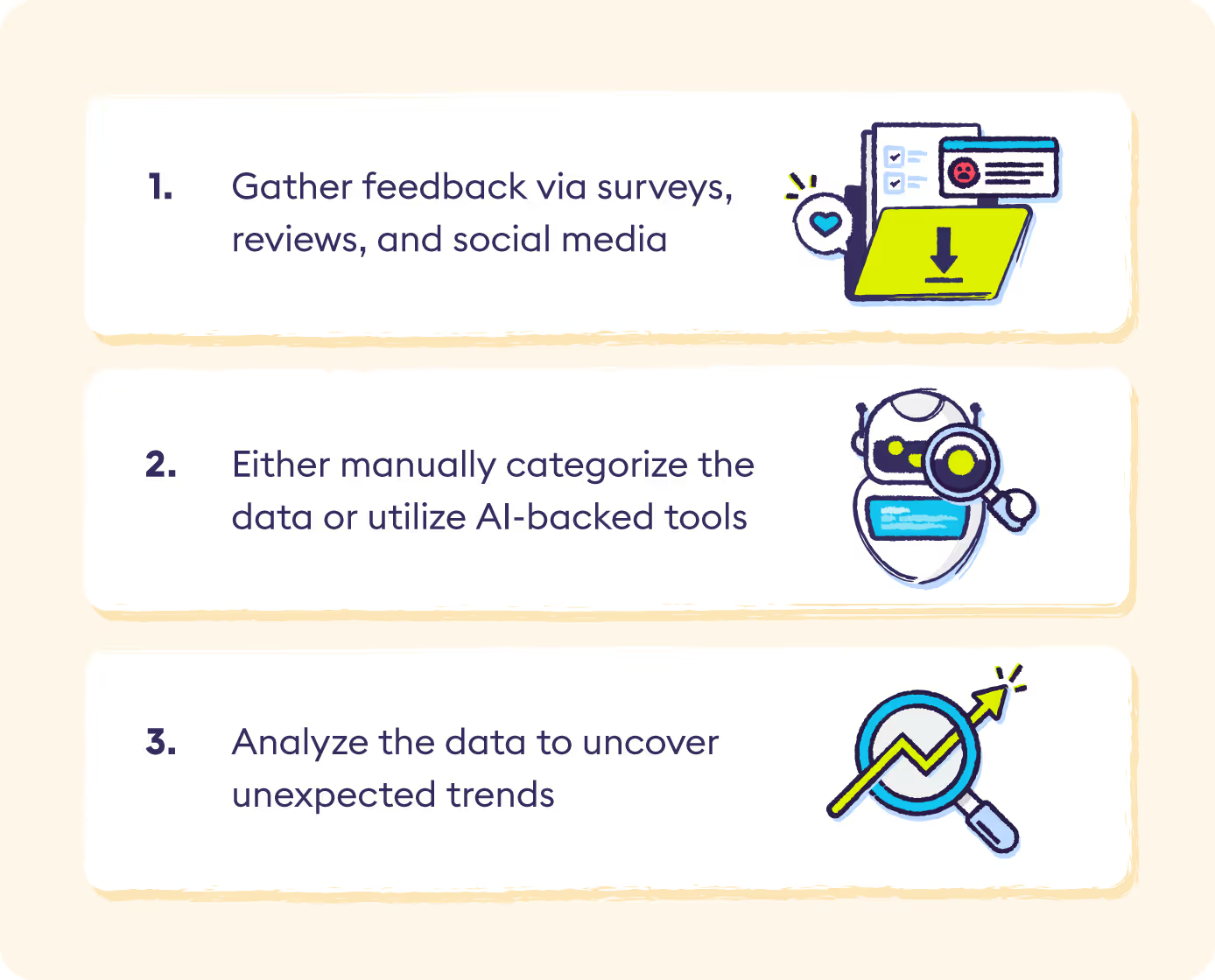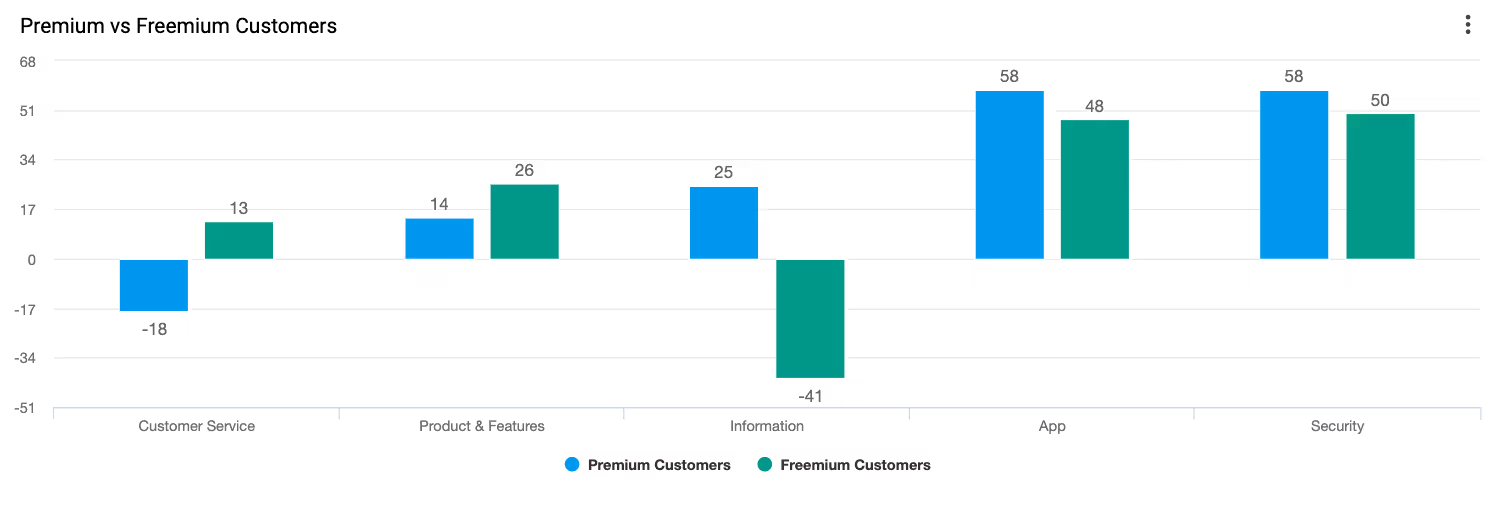Collecting customer feedback is easy. Making sense of it and acting on it is where most businesses fall short.
In 2026, successful customer experience (CX) programs don’t just listen to customers, rather they analyze feedback at scale, turning reviews, survey data, and social comments into measurable business outcomes.
This guide walks you through how to conduct effective customer feedback analysis, what pitfalls to avoid, and how to turn unstructured data into insights that improve your bottom line.
What is Customer Feedback Analysis?

Customer feedback analysis is the process of extracting insights from customer responses to things like surveys or online reviews. Having a lot of data to work with is a good start, but you’ll need to categorize, tag, and manipulate the data in order to uncover the hidden nuggets of information that will allow you to make beneficial, data-backed decisions for your business. Customer feedback analysis matters because without it, companies run the risk of becoming “data rich but information poor,” a modern business adage applicable across a wide variety of industries.
Gathering data is costly, both in terms of revenue and employee bandwidth, and data by itself means nothing. A single negative review isn’t enough evidence to confidently make a major alteration to your business. It’s only when you’re able to analyze the data and uncover overarching trends that you can make changes that truly affect your bottom line. Below we go through the basic customer feedback analysis process along with a few extra tips and tricks to make sure you’re getting the most out of your efforts.
How to Conduct Customer Feedback Analysis

Customer feedback analysis works much like any other type of data analysis. You gather the data from reliable sources, you transform the data from qualitative to quantitative, and then you analyze and manipulate the data to reveal trends.
Step 1: Gather Customer Feedback
The first step is collecting data from multiple channels to get a 360° view of the customer journey.
Common sources include:
- Online Reviews – Sites like Yelp, Capterra, or Trustpilot reveal patterns in satisfaction and product sentiment.
- Social Media Mentions – Monitor LinkedIn, X (formerly Twitter), or Instagram for both praise and frustration.
- Feedback Surveys – Post-purchase or NPS/CSAT surveys give structured insight into experience quality.
- Customer Support Transcripts – Chat and call logs reveal recurring service issues.
- Website Behavior – Analyze bounce rates, abandoned carts, or dwell times for indirect feedback.
For tips on building effective surveys, see Avoiding Response Bias in Customer Feedback.
Once collected, import all data into a centralized system (like Chattermill, Airtable, or a CX analytics platform) to prepare it for analysis.
Step 2: Categorize the Feedback
Raw customer comments don’t tell a full story until you categorize and quantify them. This step turns qualitative feedback into measurable data.
Option 1: Manual Coding
Manually assign tags and sentiment scores to each comment. Example categories:
- Themes: price, product quality, delivery, support
- Sentiment scale: very negative → very positive
This method is detailed in our guide on Coding Qualitative Data.
Option 2: Rule-Based AI
This method relies on predefined word lists (e.g., “great,” “awful,” “love,” “hate”). While fast, it can misinterpret context, a known issue called polysemy (“hot” can mean temperature or trend).
Option 3: AI-Powered Sentiment Analysis
Modern AI models combine deep learning and natural language processing (NLP) to detect emotions and themes across thousands of data points.
Chattermill’s platform, for example, uses topic modeling and multilingual sentiment detection to automatically tag and categorize large datasets, cutting hours of manual effort down to minutes.
Step 3: Analyze the Data
Now that you’ve turned your customer responses into a set of quantitative metrics, you can start digging into your data to uncover trends. You can use spreadsheets to manipulate the data and look for things like:
- Unexpectedly high or low quality ratings on certain products
- Different demographic trends, such as product preferences based on age or location
- High amounts of customer service complaints in a specific location or via a specific channel
The point of this process is to get a full view of the customer journey by understanding what is driving positive sentiment with your CX and what’s letting it down. Sometimes this can reveal hard-to-see places on the customer journey like delivery-to-door issues or a broken product.
For example, perhaps you notice that 45% of customers aged 18 - 35 rated your pricing as just 2/10 on average. From this, you might conclude that your product is priced too high to appeal to the younger portion of your customers. However, before you go about actually making changes to your business based on these trends, it’s important to ensure that the segment of responses you’re looking at is statistically significant.
If something is statistically significant, it means that you can be reasonably confident that these trends will map to the rest of your customer population and not just the sample you have data from. Take a look at our guide to survey data analysis to learn more about making sure your data is reliable.
Once you’re able to identify trends and ensure the data is statistically significant, you can start to roll out small, data-backed changes to your business with confidence. For an example of how customer feedback analysis can be used in practice, check out our report on how COVID-19 affected customers in the travel industry.
Step 4: Share Insights Across Teams
Customer insights shouldn’t live in silos. CX data only drives change when it’s accessible across departments.
- Marketing: Identify messaging that resonates with happy customers.
- Product: Understand which features delight or frustrate users.
- Support: Detect recurring complaints or sentiment drops early.
- Leadership: Link CX improvements to business KPIs like retention and LTV.
Dashboards, alerts, and visualizations ensure everyone can act on the same insights. Platforms like Chattermill unify this data into a single source of customer truth.
Step 5: Turn Insights into Action

Analysis is only valuable when it informs decisions. Use feedback insights to:
- Improve products and services
- Prioritize roadmap updates
- Optimize pricing and positioning
- Reduce churn and increase loyalty
Small, continuous improvements based on customer sentiment often outperform large one-time overhauls. Treat feedback as an iterative loop, not a one-off project.

Do I Really Need Customer Feedback Analysis?

In short, yes! Every business should be conducting customer feedback analysis. You might think that just because your company is doing well and staying profitable that you don’t need to see what your customers are saying. But what if you could be doing even better, and therefore improving your overall revenue? Though customer feedback analysis is undoubtedly useful for shedding light on existing issues, the real value of this process is to uncover problems or successes that you didn’t know about or only suspected.
For example, say your Net Promoter Score increased by five points in one month. Do you know why that happened or what you can do to ensure it continues to improve? You can understand the “why” behind the score through customer feedback analysis and uncovering the “unknown unknowns.” Otherwise, these valuable but hidden insights would have stayed out of sight, out of mind.
Extra Customer Feedback Analysis Tips
Step 6. Look at Root Problems to Understand Small Complaints
If you’re receiving a lot of niche complaints about a specific product, it’s worth taking a deep dive into that product to see if it needs to be overhauled. Though the goal of customer feedback analysis is typically to identify overarching trends and themes, sometimes a variety of small problems can point to a deeper issue.
For example, if multiple customers leave reviews about a product all complaining about different things, such as “I couldn’t get the export function to work” or “My computer crashes every time I open this,” you may investigate the product and learn that the onboarding manual file is broken. Customers weren’t able to learn how to install the software properly in the first place, leading to the variety of complaints. Remember, you don’t know what you don’t know.
Step 7. Prioritize Your Most Valuable Customers
Though the ultimate objective of customer feedback analysis is to make changes to your business that improve the customer experience, change is hard and for businesses, often expensive. Especially when making large overhauls, it’s important to prioritize changes that are going to positively affect your most important customers first.
This could be a specific customer segment if you’re a large company, but in general, existing customers are more important than new customers. This is because earning a new customer can cost up to 25x more than keeping an existing customer, so reducing churn by focusing on these specific customer needs is much more important than trying to appeal to new buyers.
Take a look at this article on the top 10 things to know before choosing a customer feedback analytics tool for tips that could save you from choosing the wrong one.
Chattermill's Customer Feedback Platform helps companies gain actionable insights through AI-backed sentiment tracking and text analytics software. Contact us for a free product demo to see if our solution could be the right fit for you.
Customer Feedback Analysis: FAQs
What is customer feedback analysis?
Customer feedback analysis is the process of examining customer opinions, reviews, and survey responses to uncover insights about satisfaction, pain points, and expectations.
Why is customer feedback analysis important?
It helps businesses understand what customers truly think, identify recurring issues, and take action to improve products, services, and overall customer experience.
What types of customer feedback are analyzed?
Both quantitative feedback (such as ratings and scores) and qualitative feedback (such as open-text comments, reviews, and social media posts) are analyzed for a complete picture.
How do businesses analyze customer feedback?
Businesses categorize feedback into themes, measure sentiment, and identify patterns. Increasingly, AI and machine learning are used to analyze large volumes of unstructured data quickly.
What role does AI play in customer feedback analysis?
AI speeds up analysis by detecting sentiment, clustering comments into themes, and uncovering hidden patterns that might be missed with manual review.
How can feedback analysis improve customer experience?
By highlighting what matters most to customers, feedback analysis allows companies to prioritize improvements, personalize experiences, and strengthen loyalty.
What are the challenges of customer feedback analysis?
Challenges include handling unstructured data, analyzing feedback from multiple channels, and ensuring insights are shared across teams to drive action.
How often should customer feedback be analyzed?
Feedback should be analyzed continuously for real-time insights, with periodic deep reviews to track long-term trends and measure the impact of improvements.




.png)











